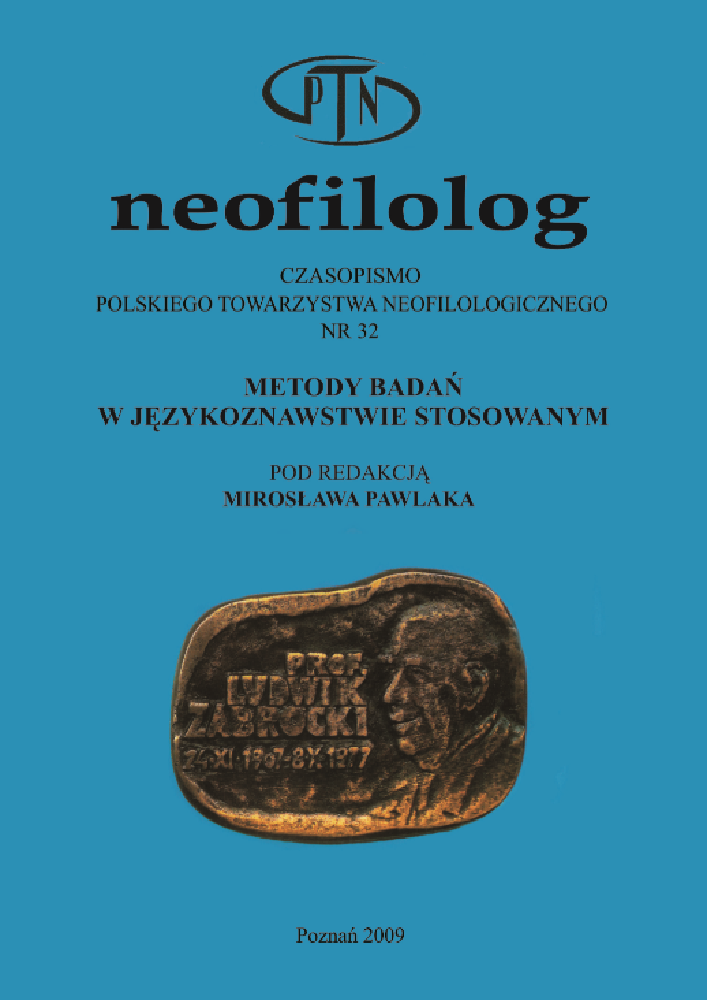Abstract
This paper outlines relevant issues in analyzing foreign language classroom communication patterns. Following a brief theoretical and historical background, it proceeds to discuss technical aspects of data collection and elaboration. Recording interaction between teachers and students is difficult but it later leads to an even more challenging task of transcribing talk. For this purpose, the article offers model instances of different traditions in compiling transcripts. However, the bulk of the present text is devoted to the exemplification of different applications of analysis of educational discourse. The samples, drawn from classroom interactions involving English, French and Polish as L2, illustrate topics such as corrective feedback, metatalk, the use of L1, and teacher questions. At the end, recommendations are given regarding further explorations and readings.
Literaturhinweise
Basturkmen, H. 2001. „Descriptions of spoken language for higher level learners: The example of questioning”. ELT Journal 55. 4-13.
Bellack, A. A., Kliebard, H. M., Hyman, R. T. i Smith Jr., F. L. 1966. The language of the classroom. Final report, USOE Cooperative Research Project, No.
New York: Teachers College Press, Columbia University.
Bernstein, B. 1990. Class, codes and control, Vol. 4: The structure of pedagogic discourse. London: Routledge.
Brown, J. D. i Rodgers, T. S. 2002. Doing second language research. Oxford: Oxford University Press.
Candlin, C. C. i Mercer, N. (red.). 2001. English language teaching in its social context. A reader. London: Routledge.
Cazden, C. B. 1988. Classroom discourse. The language of teaching and learning. Portsmouth, NH: Heinemann.
Freeman, D. 1998. Doing teacher research: From inquiry to understanding. Pacific Grove: Heinle & Heinle Publishers.
Guan Eng Ho, D. 2005. „Why do teachers ask the questions they ask?”. RELC Journal 36. 297-310.
Labov, W. 1970. Sociolinguistic patterns. Oxford: Basil Blackwell.
Long, M. H. i Sato, C. J. 1983. „Classroom foreigner talk discourse: Forms and functions of teachers’ questions”, w: Seliger, H. W. i Long, M. H. (red.). 1983. 268-285.
Lyster, R. i Ranta, L. 1997. „Corrective feedback and learner uptake”. Studies in Second Language Acquisition 19. 37-66.
Łęska, K. 2007. „‘Metamowa’ na lekcjach języka angielskiego”, w: Majer, J. i Nijakowska, J. (red.). 2007. 109-127.
Łęska, K. 2008. Teachers’ use of interaction patterns in a foreign language classroom and gains in students’ oral fluency. Częstochowa: Wydawnictwo Wyższej Szkoły Lingwistycznej.
Majer, J. 2003. Interactive discourse in the foreign language classroom. Łódź: Wydawnictwo Uniwersytetu Łódzkiego.
Majer, J. 2008. „Negotiation of form in foreign-language classroom discourse”, w: Pawlak, M. (red.). 2008. 79-94.
Majer, J. i Nijakowska, J. (red.). 2007. Język – Poznanie – Zachowanie. Studia nad psycholingwistycznymi aspektami przyswajania języka. Łódź: Wydawnictwo Uniwersytetu Łódzkiego.
Mehan, H. 1979. „‘What time is it, Denise?’. Asking known information questions in classroom discourse”. Theory into Practice 18. 285-294.
Niżegorodcew, A. 2007. Input for L2 learners. The relevance of relevance. Clevedon: Multilingual Matters.
Nunn, R. 1999. „The purpose of language teachers’ questions”. IRAL 37. 23-42.
Pawlak, M. 2004. Describing and researching interactive processes in the foreign language classroom. Konin: Wydawnictwo Państwowej Wyższej Szkoły Zawodowej w Koninie.
Pawlak, M. (red.). 2008. Investigating English language learning and teaching. Poznań – Kalisz: Wydawnictwo Wydziału Pedagogiczno-Artystycznego UAM w Kaliszu.
Pica, T. 1996. „Do second language learners need negotiation?”. IRAL 34. 1-21.
Piotrowski, S. 2006. Gestion des tâches et mode d’accés à la langue. Lublin: Towarzystwo Naukowe KUL.
Riggenbach, H. 1999. Discourse analysis in the language classroom. Volume 1. The spoken language. Ann Arbor: The University of Michigan Press.
Rowe, M. B. 1987. „Using wait time to stimulate inquiry”, w: Wilen, W. W. (red.). 1987. 102-109.
Sarangi, S. i van Leeuwen, T. (red.). 2003. Applied linguistics and communities of practice. London: Continuum.
Seedhouse, P. 2004. „The interactional architecture of the language classroom: A Conversation Analysis perspective”. Language Learning Monograph Series 4. 1-272.
Seliger, H. W. i Long, M. H. (red.). 1983. Classroom-oriented research in language learning. Rowley, MA: Newbury House.
Sinclair, J. i Brazil, D. 1982. Teacher talk. Oxford: Oxford University Press.
Sinclair, J. i Coulthard, M. 1975. Towards an analysis of discourse: The English used by teachers and pupils. London: Oxford University Press.
Spada, N. i Lightbown, P. M. 1993. „Instruction and the development of questions in L2 classrooms”. Studies in Second Language Acquisition 15. 205-224.
Swann, J. 2001. „Recording and transcribing talk in educational settings”, w: Candlin, C. C. i Mercer, N. (red.). 2001. 323-344.
van Dijk, T. 2001. Dyskurs jako struktura i proces. Warszawa: Wydawnictwo Naukowe PWN.
van Lier, L. 1984. „Analysing interaction in second language classrooms”. ELT Journal 38. 160-169.
Wilen, W. W. (red.). 1987. Questions, questioning techniques, and effective teaching. West Haven, CT: NEA Professional Library.
Wragg, E. C. 2001. Co i jak obserwować w klasie? Warszawa: Wydawnictwo Akademickie „Żak”.
Lizenz
Copyright (c) 1970 Jan Majer

Dieses Werk steht unter der Lizenz Creative Commons Namensnennung - Keine Bearbeitungen 4.0 International.
Autoren:
Die Autoren der zur Veröffentlichung in der Zeitschrift Neofilolog angenommenen Texte sind verpflichtet, den Vertrag über die Erteilung einer kostenlosen Lizenz für die Werke mit der Verpflichtung zur Erteilung einer Sublizenz CC auszufüllen, zu unterzeichnen und an die Adresse der Redaktion zurückzusenden.
Gemäß Vertrag erteilen die Autoren auf die in der Zeitschrift Neofilolog veröffentlichten Texte der Adam-Mickiewicz-Universität in Poznań eine nicht exklusive und kostenlose Lizenz und erlauben die Verwendung der Sublizenz Creative Commons Attribution-NoDerivatives 4.0 International (CC BY-ND 4.0).
Die Autoren behalten das Recht zur weiteren freien Verfügung über das Werk.
Benutzer:
Interessierte Onlinebenutzer dürfen die seit 2017 veröffentlichten Werke unter folgenden Bedingungen nutzen:
- Anerkennung der Urheberschaft - die Verpflichtung, zusammen mit dem verbreiteten Werk Informationen über die Urheberschaft, den Titel, die Quelle (Links zum Originalwerk, DOI) und die Lizenz selbst bereitzustellen;
- ohne Schaffung abgeleiteter Werke - das Werk muss in seiner ursprünglichen Form erhalten bleiben, ohne Zustimmung des Autors dürfen keine Studien, beispielsweise Übersetzungen, verbreitet werden.
Die Urheberrechte aller veröffentlichen Texte sind vorbehalten.
Sonstige:
Die Adam-Mickiewicz-Universität in Poznań behält das Recht auf die Zeitschrift als Gesamtheit (Layout, Grafik, Titel, Umschlagsprojekt, Logo usw.).
